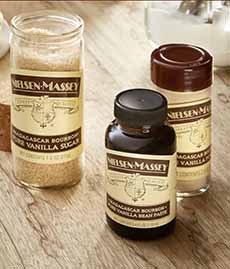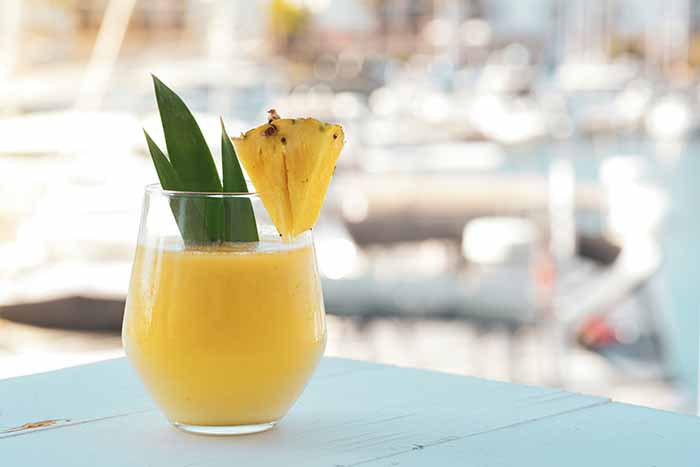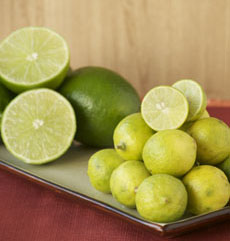|
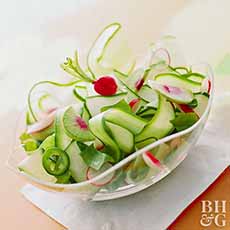
[1] (photo © Better Homes & Gardens).
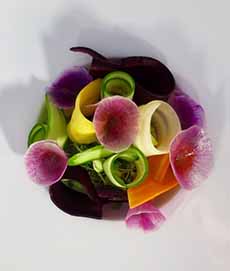
[2] You can make curled vegetables look like a bouquet (photo © Canard Inc.).
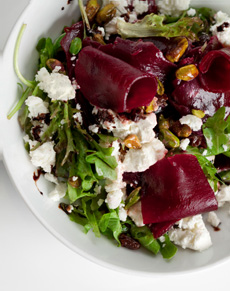
[3] Here, a beet and goat cheese salad is graced with curled beets (photo © Triomphe | NYC [now closed]).
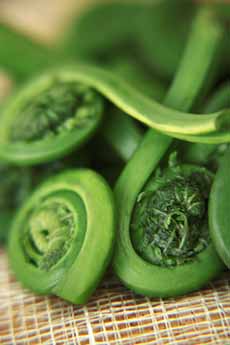
[4] If fiddlehead ferns are in season, definitely add some (photo Katharine Pollak | © The Nibble).
|
|
An easy way to turn a raw vegetable salad into edible art is to thinly shave/cut the vegetables with a vegetable peeler or mandoline, and soak them in ice water for about 20 minutes.
This will not only make the ribbons curl, but they’ll be crunchier, too.
And, some might say, they have more eye appeal—much more than a spiralized raw vegetable salad.
Are you game to try?
CHOOSE VEGETABLES THAT ARE EASY TO SHAVE
Choose vegetables that shave well.
We’ve used asparagus, beets, broccoli stalks (a great use for them!), burdock root, carrots, celery, celery root (celeriac), daikon and other large radishes, Jerusalem artichoke, jicama, kohlrabi, parsnip, scallions* and sweet potato†.
Shave them lengthwise, then place the pieces into a bowl of ice water. Keep the shaved vegetables in ice water until ready to serve.
You can serve the curled vegetables on a bed of greens, or by themselves.
RECIPE: CURLED VEGETABLE SALAD
We adapted this salad from one in Better Homes and Gardens.
Their recipe used cucumbers and radishes (photo #1). However, pick as many veggies to curl as you like, balancing beige-white vegetables with colored ones.
You can also add the jalapeno or not; and optionally, add
Crumbled cheese: asiago, blue, cotija, feta, goat, etc.
Small cheese cubes: cheddar, colby, edam, jack, swiss, etc.)
We’ve created a salad of greens and herbs. Use your favorite. We chose a baby lettuces mix and added baby arugula, basil, chives and mint. You can use crunchy romaine or any salad blend.
Ingredients
5-10 large radishes (e.g. daikon, watermelon radish)
2 medium seedless cucumbers
Optional garnish: 1 jalapeño chile pepper, seeded and sliced into rings
Salad greens of choice
3 tablespoons herbs of choice, chopped or julienned (basil, chives, dill, mint, sorrel)
For The Dressing
Pinch sugar
2-3 pinches salt
3 tablespoons olive oil
1 tablespoon white wine vinegar, lemon juice or lime juice
Optional garnish: crumbled or cubed cheese
Preparation
1. PEEL the vegetables as appropriate (e.g., carrots and cucumbers yes, asparagus and radishes no). Using a mandoline or a sturdy vegetable peeler, and cut them lengthwise into thin, ribbon-like strips. Aim for 3-inch lengths. You can elect to make them longer: The longer the strip, the less tight the curl. Try some test batches, e.g. two or three strips of each vegetable, to see what you prefer.
2. PLACE the strips in ice-water bath, and let stand until curly, about 20 minutes. You can keep them in the ice water until ready to serve. Then, drain and transfer to a paper towel and blot dry.
3. PREPARE the greens and herbs salad. Toss with the dressing (use as little dressing as needed to moisten) and add the cheese. Place in a bowl or on a plate.
4. TOP with the curled vegetables. Serve with a pitcher of extra dressing to pass.
|


